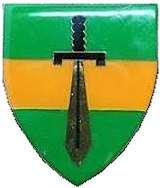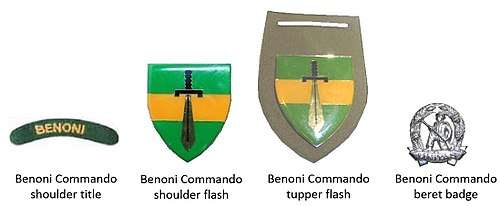Benoni Commando
Benoni Commando was a light infantry regiment of the South African Army. It formed part of the South African Army Infantry Formation as well as the South African Territorial Reserve.
| Benoni Commando | |
|---|---|
 Benoni Commando emblem | |
| Country | |
| Allegiance | |
| Branch | |
| Type | Infantry |
| Role | Light Infantry |
| Size | One Battalion |
| Part of | South African Infantry Corps Army Territorial Reserve |
| Garrison/HQ | Benoni, Gauteng |
History
Origin
Operations
Under the UDF
Rebel Commando
Members of the Benoni Commando sided with the 1922 Miners Strike Rand Rebellion.[1][2] At 05:00 on 12 March 1922, the Union Defence Force (UDF) attacked Benoni. The objectives was to defeat striking commandos at a steel factory and then move into the rest of the town. The Government forces commenced their attack at 11:00 and immediately came under heavy fire. The attack on the steel factory was supported by artillery fire from two positions, which contributed to the striker commandos being dislodged. The attack then continued along Main Reef Road. Commandant. P. Botha and a portion of the Standerton East Commando joined the fight at 16:00. The attack was called off at 17:00 in order to reorganize and consolidate positions before dark. Ammunition and arms arrived later that night and was distributed. The reinforcements consisted of the rest of the Standerton East Commando, the Blesbokspruit Commando (Standerton), the Heidelberg Commando, the Hoogveld Commando (Heidelberg), the Roodekoppe Commando (Standerton), and the Standerton West Commando. The attack continued on 13 March. The operation went according to plan and the besieged police and Permanent Force was relieved. An instruction was subsequently issued to arrest all male residents of Benoni.[3]
Under the SADF
During this era, the unit was mainly engaged in area force protection, search and cordons as well as other assistance to the local police.
As an urban unit, this commando was also tasked with protecting strategic facilities as well as quelling township riots especially during the State of Emergency in the 1980s.
Under the SANDF
Disbandment
This unit, along with all other Commando units was disbanded after a decision by South African President Thabo Mbeki to disband all Commando Units.[4][5] The Commando system was phased out between 2003 and 2008 "because of the role it played in the apartheid era", according to the Minister of Safety and Security Charles Nqakula.[6]
Unit Insignia

Leadership
| From | Honorary Colonels | To |
| From | Commanding Officer | To |
| From | Regimental Sergeant Major | To |
See also
- South African Commando System
References
- http://www.politicsweb.co.za/opinion/whiteonwhite-violence-the-1922-rand-revolution
- http://www.sahistory.org.za/sites/default/files/DC/sloct93.8/sloct93.8.pdf
- Fokkens, A.M. The role and application of the Union Defence Force in the suppression of internal unrest 1912 - 1945,Faculty of Military Science, Stellenbosch University.
- Col L B van Stade, Senior Staff Officer Rationalisation, SANDF (1997). "Rationalisation in the SANDF: The Next Challenge". Institute for Security Studies. Archived from the original on 16 March 2016. Retrieved 5 March 2015.
- "About the Commando system". Archived from the original on 6 December 2007. Retrieved 17 January 2008.
- de Lange, Deon. "South Africa: Commandos Were 'Hostile to New SA'". Cape Argus. Retrieved 5 March 2015.